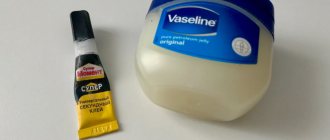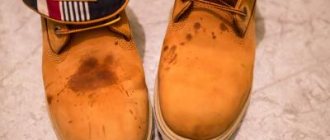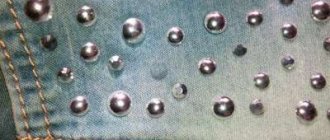As you know, glass wool is a fibrous material used for thermal insulation purposes. The main component in the production of glass wool is glass.
In this regard, like glass, glass wool fibers have a crystalline structure. All this explains the appearance of itching when working with glass wool - small particles of glass dig into the skin and also get into the pores, and this causes irritation and itching.
One of the mandatory conditions when working with glass wool is the use of special clothing and respiratory protection (for example, a respirator) and eyes (you can use safety glasses).
Similar protective equipment must be used when working with mineral wool. When working with glass wool or mineral wool you need to look like the image below.
This protective clothing is inexpensive, but its use will prove to be a big savings later. Why? Read on.
Be sure to take off all your good clothes and put on overalls - if you don’t do this, then all your clothes will become unusable and, as a rule, they can no longer be cleaned.
An important rule that must be remembered when working with glass wool: even if glass wool gets on the skin, under no circumstances should you rub this area! If you start rubbing, small particles of glass will dig into your skin and it will only get worse. If glass wool gets onto an unprotected area of skin, it must be carefully shaken off and under no circumstances rubbed!
After the work is completed, it is necessary to clean the body of glass microparticles. To do this, you need to take a shower, but you should remember some rules that must be followed in order to prevent irritation from glass wool:
1. In order to wash off particles of glass wool fibers, you need to take a cool shower. Make the shower pressure as high as possible. Before taking a shower, you need to shake off your head, because there is likely to be a significant amount of glass wool particles accumulated on your hair.
2. Under no circumstances should you take a hot shower - this is due to the fact that when taking a hot shower, the pores of our skin expand and glass microparticles can penetrate them. This will only make the itching worse!
3. When taking a shower, do not use a washcloth or soap - just rinse.
4. After rinsing under a strong stream of cool shower, you need to dry without using a towel.
If after cleaning the glass wool from the skin there is itching, you can try: wet a towel with cold water and gently apply it to the inflamed area of the skin and wait a little. If the itching of the skin continues, then aloe, applying milk to the irritated skin can help relieve it, and sometimes a calendula solution helps.
Similar actions should be performed after gluing the glass wallpaper. Fiberglass wallpaper, like glass wool, can also leave an unpleasant itching on the skin, because... this building material is also made of fiberglass.
1. Clothes must be vacuumed. There is no need to immediately try to wet clothes - this can only do harm, because it is much more difficult to remove glass wool from wet clothes than while the clothes are dry. Carry out all actions to get rid of glass wool strictly wearing rubber household gloves (such seals are sold in any hardware store) - if you do not use gloves, then you will have to clean the glass wool not from clothes, but to treat the skin.
2. After using the vacuum cleaner, it is necessary, without removing rubber gloves, to wash the clothes by hand. Wash separately from other laundry! It is advisable to repeat hand washing 3-4 times. When you wash your clothes, keep in mind one piece of advice: you don’t need to rub the laundry, you just need to rinse it, otherwise the glass wool particles will stick into the threads of the clothes and then everything will be much more complicated. Rinse clothes with a powerful stream of water between washes.
4. When the clothes are dry, take the vacuum cleaner again and vacuum the clothes again.
If these actions do not lead to the desired result, then there are two ways out:
1. Try dry cleaning your clothes.
2. Throw it away.
Also keep in mind that if the clothes on which glass wool has come into contact are wool, then most likely you will have to part with them - it is almost impossible to clean woolen clothes from glass wool.
In order to avoid the need to clean clothing or skin from glass wool, use protective equipment!
In the event that you work with fiberglass, do repairs, or your child is a real climber who is drawn to all sorts of curious and strange things (and nowadays a child can easily stumble upon fiberglass even just going for a walk outside) and to construction sites , or if you or your boyfriend/husband are always DIYers (you can never really rule out fiberglass), you may have to deal with splinters or thorns made from this material, which are known to easily penetrate the skin. But sometimes it can be difficult to grab and pull fiberglass out of leather, because this fiber has a very unpleasant tendency to break easily when pressure is applied to it. However, there are a number of ways—besides pliers and tweezers—you can try to remove fiberglass splinters. Assess the size of the problem and immediately select the optimal method of removing the splinter from those listed below, so as not to aggravate the problem.
You will need: - high-quality adhesive tape; — wax for hair removal and a set for it; — microwave (it’s just faster, but you can get by with any analogues); - universal white glue.
1. Very gently touch the area with the splinter with the adhesive surface of the tape. The tape should be as sticky as possible so that you don't have to press down on it to get a better grip, and you'll have a much better chance of getting a firm grip on the fiberglass splinter. Tap the splinter area under the tape very lightly to ensure that the fiberglass spike sticks to the tape and comes out with it. If the splinter(s) are thin and, in principle, mostly located on the surface, it is better not to put pressure on them at all, but simply apply tape.
Peel off the tape carefully: if you tear it off sharply, the chances that the splinter will remain inside are higher, besides, by acting slowly, you can always understand whether the splinter is stuck, whether it comes out and how well - or whether you need to press a little more on the adhesive tape. If the splinter comes out, also act slowly so that it does not fall off - when you pull it to the surface, it will be easier to pick it up - you can also very carefully use the adhesive tape on the side. The more often - with repeated attempts - you have to press the tape over the area with the splinter, the more likely it is that the latter will go deeper, so again: very carefully and slowly. Patience!
2. Heat the wax from the hair removal kit - microwave for about 10 minutes. You can also use a steam bath (in other words, read how else you can heat the wax in the instructions for the kit). Spread a layer of liquid wax over the area with the fiberglass splinter and cover the wax with the tissue/tape provided in the kit. Allow the area to dry and cool quietly for 5 minutes (without pressing) and then pull the napkin with the wax upward (also not too harshly, but this is faster): the wax sets better due to the fact that it is liquid and because of this it penetrates into all the recesses, so that the splinter will most likely come out. The layer of wax should be medium: apply it too thick, and the napkin will not grab the splinter; too thin and the wax won't adhere to the splinter.
3. Spread a layer (similar in thickness to the one above) of all-purpose white glue over the area with the splinter. Let the glue dry completely and scrape it off the skin. The splinter should come out along with the glue. Here you can also use the same napkins (but not paper ones!) as in step 2, or strong polyethylene - the main thing is not to press hard on them so that the napkin sticks to the glue, and not to the skin - this way the glue will be easier remove at the end. This method is perhaps the most optimal and effective (the wax is still thicker and sets worse), but if the splinter is visible on the surface, it is better to try the first option first. If you suspect that the glue will not help - the splinter is too deep - consult a doctor: by cleaning off the glue, you can easily break the splinter and/or make it go even deeper.
.
Other methods: steam the area with the splinter so that it comes out easier; Apply liquid cream to also make it easier for the splinter to slip out, then simply wipe with a soft cloth. To speed up the drying of the glue, you can use a hairdryer!
Hello to all those few readers who found me in the vastness of the world. Today I’ll give you some self-tested advice on how to get rid of glass wool on your skin.
Not long ago, at work, I was doing a little cleaning of trash in the industrial premises; among the trash, as luck would have it, there were small pieces of glass wool, the same Soviet-hardened one, prickly and unpleasantly itchy when it came into contact with open areas of the skin. I had to get rid of the glass wool manually, and my hands were wearing ordinary cotton gloves, which, of course, will not protect against cotton wool. As a result, after a few minutes my hands began to itch terribly and I felt an unpleasant tingling sensation from the glass particles. I didn’t want to endure this feeling all day, but soap, as you know, won’t get rid of glass wool particles. Therefore the question
How to remove glass wool from clothes and skin, how to treat your hands
Due to the presence of glass fibers in glass wool, removing its components from clothing and skin is difficult. The material is very irritating to the skin and causes itching. It is necessary to work with it only in special clothing. Various methods are used to remove glass wool from the body and clothing.
Recommendations for cleaning the skin from this type of mineral wool
Do not rub the area where fragments of material have fallen. If its particles settle on your hands, then it is enough to shake them off or blow them off with a strong stream of air.
When working with the material you need to use glasses. If glass fibers get into your eyes, you should start blinking frequently. This will facilitate the rapid removal of fiberglass particles from them. Do not immediately rinse your eyes with water. This will make the situation worse.
You can wash your eyes only 30-35 minutes after fiberglass particles get into them. This must be done carefully. Don't rub your eyes too much. They need to be washed with plenty of cool water.
If the procedure does not help, you should contact an eye surgeon.
If glass wool fragments get into your eyes, you should immediately start blinking rapidly.
When working with the material, it is important to use a hat. If glass wool gets on your scalp, you need to shake your hair with your hands. This should be done with gloves. Your head should be bowed low over the bathtub. Eyes must be closed. Fibers can become trapped and cause irritation.
Below is a step-by-step method on how to remove glass wool from your skin. Necessary:
- Take a non-hot shower immediately. The water pressure should be maximum. Do not rub your skin with a washcloth. Do not use soap.
- Take a shower again. The water in it should not be hot. When washing, you can already use soap and a washcloth.
Allow the body to dry. Do not dry your body with a towel after showering.
Important! Do not wash in hot water. The shower should be cool. Hot water causes skin pores to expand. Microparticles of fiberglass may get caught in them, which will increase irritation.
If your body itches after taking a shower, it is recommended to apply a towel soaked in cold water to the exposed areas. You need to keep it on the skin for several minutes. If irritation does not go away, it is necessary to use emollients. You can moisten the skin with aloe juice or calendula solution.
You can eliminate irritation from glass fibers getting on your skin using aloe juice.
There are ways of what to do if your hands itch after removing glass wool from them. You can put a towel soaked in milk on them. It is recommended to use a softening hand cream. You can also apply shaving foam to the skin of your hands.
Ordinary plasticine will soften the itching on your hands. You need to knead it thoroughly. After this, you need to scrub your hands and anoint them with cortisone cream.
Important! You can lubricate the damaged skin with vegetable oil, wait a couple of minutes and rinse it off with warm water. Finally, treat the damaged area with peroxide.
Recommendations for cleaning fiberglass particles from clothing
It is necessary to work only in special clothing. If the material gets on ordinary things, you need to quickly remove it from them. Below is a method on how to remove glass wool from clothing. Necessary:
- Vacuum all items.
- Wash them by hand. Clothes must be washed separately from other items and only with gloves. Do not rub the laundry during washing. Simply rinse it thoroughly by placing it under a strong stream of cold water.
- Dry clothes thoroughly.
- Vacuum things again.
Remove fiberglass residue from clothing by rinsing it under a strong stream of cold water.
Do not immediately wet laundry that has been exposed to glass fibers. They penetrate deeper into wet fabric, after which it will be difficult to remove them from clothing. It is recommended to blow off fragments of material from things with a vacuum cleaner running at full power. Additionally, you can go over things with an antistatic roller.
A roller can be used to remove fiberglass from items.
Do not machine wash clothes containing fiberglass particles. Suitable for hand washing only. It is recommended to repeat this up to four times. If washing at home does not solve the problem, then you need to take the items to the dry cleaner. It is important to inform employees in advance that there are fiberglass fragments left in the clothing.
You should not work with the material in woolen items. In the future, it will be difficult to clean them from glass wool. You should not attempt to remove mineral wool fragments from clothing if it is heavily contaminated with them. Even repeated washing will not remove the glass fibers from it. It is recommended to throw away such clothes and buy new ones.
What you need to pay attention to when choosing workwear for a builder
If finishing work involves the use of glass wool, then you should choose the right workwear for it. She must be:
- dense;
- continuous (do not have any open areas);
- made from dirt-repellent materials (for quick cleaning of fiberglass);
- wear-resistant.
It is necessary to give preference to overalls in the form of a suit. The jumpsuit has open areas in the neck and arms. During operation, glass fibers may get caught on them and cause irritation.
As an alternative to thick fabric for workwear, it is allowed to use laminated fabric. It is also suitable for working with glass wool. The following items should be included with the overalls:
- gloves made of polymer fabric;
- respiratory shield;
- glasses.
When working with glass wool, the builder must be equipped with a suit made of thick fabric and protective equipment (goggles, respirator, gloves)
Overalls must be resistant to cutting damage. It should not be deformed after washing. You should choose workwear made from polymer fabrics. A product made from cheap synthetics has low protective properties. It wears out quickly. Overalls must be fire resistant.
To work with glass wool, it is recommended to purchase a product that does not have open pockets. Dust and other particles often accumulate in them. Workwear must be accompanied by durable shoes with thick soles. You must select the product by size. The item should not restrict movement. You should purchase moisture-resistant workwear.
Health effects
All products of this company are made exclusively from safe and environmentally friendly materials. This is confirmed by both environmental and hygienic certificates. The document on environmental friendliness indicates research conducted in. Tests were also carried out by the Scientific Center for Children's Health. In both the first and second cases, it was proven that Isover products do not pose a threat to the health and life of an adult or a child.
The hygiene certificate states that all studies were carried out on the basis of current sanitary and epidemiological rules and regulations. As a result, experts concluded that Isover insulation products fully comply with standards and regulations and do not pose a danger to human health.
Moreover, insulation containing basalt boasts a high degree of fire resistance. Not all products have such characteristics. The remaining products simply belong to the group of non-combustible materials.
Isover thermal insulation is deservedly popular in the European and World markets. In addition to high environmental characteristics, these products have high levels of sound and heat insulation.
*information is posted for informational purposes; to thank us, share the link to the page with your friends. You can send material interesting to our readers. We will be happy to answer all your questions and suggestions, as well as hear criticism and suggestions at
Glass wool is a very effective thermal insulation material (a type of mineral wool), the production of which uses waste from the glass industry. Almost every boy knows that if you touch this material with an open part of the body, itching and rash are inevitable, as if from nettles.
Glass wool must be handled very carefully as it can cause an allergic reaction. When working with it, there is a whole set of safety rules that make it possible to eliminate undesirable consequences.
Glass wool is supplied in rolls. In some cases, its layers need to be cut (in accordance with the parameters of the surface that is being insulated). A sharp knife is used for this. The size of the cut mats should exceed the previously measured values by several centimeters. This will create the necessary density of the material and will not affect the thermal protection performance at all.
When working with glass wool, you must wear a dust blower, gloves and safety glasses. In addition, it is advisable to have clothing that can cover all parts of the body (tight overalls). As soon as the work with glass wool has been completed, it is important to carry out a thorough wet cleaning of the room. The result of all manipulations should be a shower.
Upon direct contact with glass wool, the first signs of irritation appear on the skin, itching, redness and other unpleasant sensations are observed. The safety measures indicated above can protect the human body from the negative effects of glass wool, however, it is not always possible to avoid direct contact.
Opinion of the State Department of Hygiene
Studies have shown that harmful emissions do occur, but their concentration in the room is no higher than from particle boards. Moreover, not all fibers are dangerous, but only those that have a thickness of less than 3 microns and a length of more than 5 microns. Surprisingly, the chemical composition of the fibers themselves does not matter. Most of the asbestos mineral wool fibers, which are now out of production, had precisely these parameters.
To avoid harm to your health, experts recommend purchasing mineral wool insulation from large manufacturers who produce the material based on GOST standards, and not their own technical specifications. For greater confidence, you can inquire about the availability of certificates from regulatory organizations (FEZ, Rospotrebnadzor). Carcinogenic effects can be avoided if you use mineral wool in the form of slabs. The main requirement of the state hygiene department is to prohibit the use of loose mineral wool. It is important to carry out the installation correctly, with careful subsequent waterproofing. If doubts still arise, then it is better to choose another, more environmentally friendly insulation.
Sources:
- Mineral wool: GOST
- Mineral wool: comparative characteristics
- The effect of mineral wool on human health
A huge range of insulation materials makes you think about the correctness of your choice. Isover insulation products can be called the most popular products. Despite this, many are concerned about the quite reasonable question of the environmental friendliness and hygiene of the material.
Glass wool on hands. itches and pricks. What to do?
Due to the presence of glass fibers in glass wool, removing its components from clothing and skin is difficult. The material is very irritating to the skin and causes itching. It is necessary to work with it only in special clothing. Various methods are used to remove glass wool from the body and clothing.
In case of a burn, it is strictly prohibited:
- lubricate the burn area with vegetable oil, alcohol-containing preparations, iodine, brilliant green;
- sprinkle with starch;
- apply burn ointment and other medical products to the hot surface of the skin;
- apply fermented milk products to the damaged area;
- pierce or cut through the formed blisters on the skin;
- independently clean the wound from dirt or remnants of clothing;
- wash the burn with water with the addition of soda or citric acid;
- apply a plaster to the burn.
First aid for burns
A burn occurs as a result of exposure to high temperatures and immediately turns into an open wound, accessible to any microbes. Therefore, the first and most important thing to do is to free the damaged area from clothing and immediately cool the burned area. Ice from the refrigerator, snow, very cold water or any frozen product will do.
Symptoms
After receiving an injury, a person may feel a strong burning sensation in the visual area.
- lacrimation;
- photophobia;
- swelling;
- headache;
- burning sensation in the visual analyzer;
- dizziness;
- redness of the mucous membrane;
- the appearance of circles or flickering;
- feeling of soapiness of the skin;
- impairment or complete loss of vision.
There are 4 degrees of burns, which depend on the severity of tissue damage:
- Initial. The surface layers of the epithelium are damaged with the development of redness and slight swelling.
- Average. The cornea is completely damaged and a film forms on it along with erosion.
- Heavy. Necrosis of the deep layers of the eye occurs. As a result, a white-yellowish scab is formed, and the cornea becomes dull and swells greatly.
- Very heavy. The cornea, conjunctiva and sclera are affected. A scab is formed with a brownish-gray tint, and the cornea has the appearance of porcelain.
Why is glass wool dangerous for humans?
As mentioned above, glass wool has a fibrous structure and consists of tiny microparticles, for which formaldehyde resins are used to hold them together. When these resins break down, they release phenol into the air, which is considered a strong poison. Fibrous structure of glass wool
Inhalation of even small doses of phenol can cause poisoning of the body and lead to diseases of the central nervous system. Phenol emissions are especially dangerous in hot summer weather and in a warm room.
European Union scientists conducted research to study the properties of glass wool. According to their results, some varieties of this popular insulation are classified as the second hazard group; they contain carcinogenic substances. Solid resin content within 4% is considered safe for the human body.
Source of the article: https://uteplitel-minol.ru/utepliteli/kak-ubrat-steklovatu-s-kozhi.html
How to clean glass wool from body and clothes, how to wash mineral wool.
We study all the ways to remove glass wool from clothes and skin in order.
Hello to all those few readers who found me in the vastness of the world. Today I’ll give you some self-tested advice on how to get rid of glass wool on your skin.
Not long ago, at work, I was doing a little cleaning of trash in the industrial premises; among the trash, as luck would have it, there were small pieces of glass wool, the same Soviet-hardened one, prickly and unpleasantly itchy when it came into contact with open areas of the skin. I had to get rid of the glass wool manually, and my hands were wearing ordinary cotton gloves, which, of course, will not protect against cotton wool. As a result, after a few minutes my hands began to itch terribly and I felt an unpleasant tingling sensation from the glass particles. I didn’t want to endure this feeling all day, but soap, as you know, won’t get rid of glass wool particles. Therefore the question
Environmental friendliness and safety
The most important issue for many people when choosing insulation is environmental friendliness. It is worth saying that ISOVER uses glass wool and stone wool as the basis for the production of heat and sound insulation. Due to the careful processing of the pressing, the company’s engineers assure the high degree of environmental friendliness of their products. To confirm this, you can see numerous environmental certificates of conformity on the company’s website. isover insulation is made exclusively from natural materials, therefore its environmental friendliness and safety leave no doubt.
Tips for cleaning glass wool from your body
After the work is completed, it is necessary to clean the body of glass microparticles. To do this, you need to take a shower, but you should remember some rules that must be followed in order to prevent irritation from glass wool:
1. In order to wash off particles of glass wool fibers, you need to take a cool shower. Make the shower pressure as high as possible. Before taking a shower, you need to shake off your head, because there is likely to be a significant amount of glass wool particles accumulated on your hair.
2. Under no circumstances should you take a hot shower - this is due to the fact that when taking a hot shower, the pores of our skin expand and microparticles of glass can penetrate into them. This will only make the itching worse!
3. When taking a shower, do not use a washcloth or soap - just rinse.
4. After rinsing under a strong stream of cool shower, you need to dry without using a towel.
5. Next, you should take a cool shower again, but using a washcloth and shower gel or soap.
If after cleaning the glass wool from the skin there is itching, you can try: wet a towel with cold water and gently apply it to the inflamed area of the skin and wait a little. If the itching of the skin continues, then aloe, applying milk to the irritated skin can help relieve it, and sometimes a calendula solution helps.
Similar actions should be performed after gluing the glass wallpaper. Fiberglass wallpaper, like glass wool, can also leave an unpleasant itching on the skin, because... this building material is also made of fiberglass.
Dish detergent
The washing gel contains not only particles that destroy fat. The structure includes high-quality cleaning components that remove difficult stains. The method goes through the following stages:
- the product in its pure form is poured onto the stain;
- rub a little so that the substance is absorbed into the fabric;
- after 30 minutes, clothes should be cleaned in cold water;
- The item is loaded into the washing machine, setting the cold mode.
If there is no result, the procedure is repeated or another method is used.
Best answers
Samoilenko Vadim:
spill with summer water. but for a long time
siddis:
How much does this robe cost, is it really impossible to buy it anymore, is it a fancy dress embroidered with gold? NO. This is a robe. Buy another one. Write this one off as low value.
Lelka:
It would not be possible to wash it off, but first to remove it from the clothes with a sticky roller. It is unlikely to come off when washed.
you can’t wash it, since glass wool is wool with rubble glass, but you can wash it, but only if there are other clothes under the glass wool clothes
LIOKO:
I doubt it's possible
Andrey Volkov:
Grandfather Au:
no way - just collect it with a round sticky “brush” I don’t know what it’s called then a vacuum cleaner
Igor Iskandarov:
Wash two or three times.
Advantages
One of the main advantages of glass wool over basalt mineral wool is its cost. It is much cheaper due to the more affordable cost of raw materials and cheaper transportation. Glass wool has excellent compressibility and elasticity and is capable of reducing its volume in packaging by 6 times. When unpacked within 20-40 minutes, it restores its volume. The most famous manufacturers of glass wool are Isover, Ursa, Rockwool, etc. Glass wool is produced in slabs, rolls and mats, and can be produced reinforced and with a reflective layer.
Adviсe
- Sometimes soaking the damaged area in cold or cool water is enough to soften the fiberglass particles and fall out of the skin. Don't rub your skin. Find a well-lit area and use a magnifying glass to check if any fiberglass remains in the leather. If irritation persists, consult a doctor.
- Remove large strands of fiberglass using duct tape. Then rub the skin with tights to get rid of any remaining small particles.
First aid
- don't itch. If small fibers get on the skin, additional mechanical damage to the skin will only worsen the situation.
- act carefully. If glass wool dust falls on your hair, you need to carefully shake it off, closing your eyes, and wash your hair thoroughly at home.
- Always take a shower (water temperature at room temperature), which helps reduce skin irritation and remove all small fibers of glass wool. It is important not to use a bathtub, but to give preference to a shower with relatively high pressure. You need to wash yourself without using any hygiene products or washcloths. The former expand the pores, facilitating the penetration of unwanted elements into the inner layers of the skin, while the latter will clearly retain those same irritants - microparticles.
If glass wool dust gets into your eyes, it is important to immediately rinse them with cold water under strong pressure. Obviously, the mucous membrane will be irritated. If symptoms have not gone away after 2 hours (burning and redness), you should immediately visit an ophthalmologist.
Firstly, if glass wool gets on your skin, do not scratch the affected area under any circumstances, as this will only rub glass needles into your body.
While insulating the krisha, the husband inhaled cotton wool dust and felt heaviness in his lungs. What to do?
Is it too late to drink Borjomi if the kidneys have fallen off? You’re not smart enough to put on a mask, gloves and goggles?
In general, this is very dangerous, what this cotton wool consists of is toxic to the human body, even fatal. Run to the doctor in the morning!
Well, fuck it... how is that?? ? They don't seem to be small. I had to wear a respirator. And now, just go to the doctor, as if there were no complications.
Ooty-way! How gentle we are. During the season I breathe tons of dust from the insulation and thank God I’m alive and well. Stupidly excuses himself!
Well, if you are too lazy to call an ambulance, then at home you can - breathe in the steam (boiled potatoes in their jackets) - drain the water, lean over without a lid, and cover with a towel. Be careful with burns! . Throw sage and bay leaves into the pan. Drink brewed chamomile. Also, steam with honey, rosemary, mint - everything helps to separate the layer of mucus from the walls of the trachea, lungs and expectoration. There are medications, but I won’t write them to you - complications are possible - only an on-site specialist can give them to you. ...if there are no problems with digestion and the cardiovascular system - 2 glasses of cognac... ...2 analgin tablets in a pan...
Acc... bronholutin... travesil... or change FILTERS
In such cases I drink a warm beer)))
You need to see a doctor. Why didn't you put on a respirator?
Yes, he just caught a cold on the roof!! expectorants - elecampane. . but .. before giving expectorants, you first need to wait for the sputum to mature, then take steps to liquefy it (either with a steam inhaler or with tablets) - otherwise you will only tear your lungs.
If you are not a child, it’s time to know that drugs for removing phlegm are divided according to the spectrum of action .. that with inflammation, at first you hear hard breathing (difficulty breathing .. a feeling of fullness and heaviness) ... and only then it goes into the wet phase.
Keep an eye on the temperature, whether there are wheezing .. whistles .. behind the nasolabial triangle (cyanosis = pneumonia).
When the lungs become dusty, you need to expand the bronchi (noshpa) and inhale with hot, soft steam. . is a good substitute for inhalation using an esiga or hookah (possibly without tobacco) or a pharmacy inhaler
you should have at least tied a scarf over your face or a medical mask, this dust can cause cancer, especially glass wool
Article information
English: Remove Fiberglass Slivers from Your Skin, Español: quitar astillas de fibra de vidrio de tu piel, Deutsch: Glaswolle von der Haut entfernen, Português: Remover Fragmentos de Fibra de Vidro da Pele, Italiano: Rimuovere i Frammenti di Fiber di Vetro dalla Pelle, Bahasa Indonesia: Mengeluarkan Serpihan Kaca Serat dari Kulit, Français: retirer des échardes de laine de verre de la peau, Nederlands: Glaswolsplinters uit je huid verwijderen, Tiếng Việt: Loại bỏ vụn sợi thủy tinh trên da, ا لعربية: إزالة شظايا الألياف Quote:去除皮肤上的玻璃纤维碎片, 한국어: 피부에 박힌 유리 섬유 파편을 빼내는 방법
This page has been viewed 10,626 times.
Step 2
In general, you need to protect your eyes from getting glass wool and wear special glasses, but if this happens, start blinking rapidly. This will remove the glass from your eyes. Only after half an hour can they be washed.
Step 3
If glass wool gets on your body, take a cold shower. Do not use soap or shower gel and a washcloth or sponge. In addition, the water pressure should be as strong as possible.
Step 7
Items that have been exposed to glass wool must be washed separately from all other items. Moreover, it is better to do this with laundry soap and gloves. Carry out 3-4 washes.
Step 8
And do not forget that it is recommended to work with glass wool only in special clothing or at least with protected eyes, respiratory tract (respirator) and clothing that completely covers the body.
Firstly, if glass wool gets on your skin, do not scratch the affected area under any circumstances, as this will only rub glass needles into your body.
Step 2
In general, you need to protect your eyes from getting glass wool and wear special glasses, but if this happens, start blinking rapidly. This will remove the glass from your eyes. Only after half an hour can they be washed.
Step 3
If glass wool gets on your body, take a cold shower. Do not use soap or shower gel and a washcloth or sponge. In addition, the water pressure should be as strong as possible.
Step 7
Items that have been exposed to glass wool must be washed separately from all other items. Moreover, it is better to do this with laundry soap and gloves. Carry out 3-4 washes.
Step 8
And do not forget that it is recommended to work with glass wool only in special clothing or at least with protected eyes, respiratory tract (respirator) and clothing that completely covers the body.
Hello to all those few readers who found me in the vastness of the world. Today I’ll give you some self-tested advice on how to get rid of glass wool on your skin.
Not long ago, at work, I was doing a little cleaning of trash in the industrial premises; among the trash, as luck would have it, there were small pieces of glass wool, the same Soviet-hardened one, prickly and unpleasantly itchy when it came into contact with open areas of the skin. I had to get rid of the glass wool manually, and my hands were wearing ordinary cotton gloves, which, of course, will not protect against cotton wool. As a result, after a few minutes my hands began to itch terribly and I felt an unpleasant tingling sensation from the glass particles. I didn’t want to endure this feeling all day, but soap, as you know, won’t get rid of glass wool particles. Therefore the question
Recommendations for parents of young children
The situation when a child swallows glass is very dangerous. It is worth teaching children to chew their food thoroughly. But when we are talking about a small age, it is difficult to predict and warn everything. The baby strives to explore the world, and this happens with the help of his mouth as well. The child needs to smell, touch and preferably lick an interesting thing that he has not seen before. To minimize risks, you should:
- Do not leave the child unattended . When the dangerous period of crawling and first steps begins, the desire to master the world around us is most acute. Parents should find the time and opportunity to be close to their children and make sure that no foreign objects get into the baby’s mouth;
- Do not feed from glass containers . Despite their hygiene, glasses and bowls, even with a microcrack, will become dangerous for a child. And a tongue cut is the most harmless of them;
- Remove glass objects from the access area . Anything that is within reach of prying hands must be safe. Ordinary objects need to be approached with a healthy dose of criticality. Even small glass inserts are dangerous;
- Choose toys carefully . Even the most harmless-looking dolls or cars can have sharp parts in their design. Therefore, such things are not allowed for games under 3 years of age;
- Listen to the behavior of the little person . Minor deviations in the child's condition - lethargy, fever, vomiting, hiccups, crying, difficulty breathing - all these are alarming signals for a caring parent. It is better to consult a doctor once again and spend a little effort on examination and find out what the reason is, than to waste precious time.
How to get rid of glass wool
Since there wasn’t much to lose, I decided to get rid of the glass wool by washing my hands with Remoskin cleansing paste
And lo and behold, after just one use, the unpleasant sensation from the presence of glass wool particles on the hands disappeared. So, it turns out, the solution to the problem was always at hand, in my personal locker.
Now you know how to get rid of glass wool without any problems or harm to the skin. I hope my advice helped you.
Source of the article: https://fugar-kamin.ru/utepliteli/kak-ochistit-telo-i-odezhdu-ot-steklovaty.html











